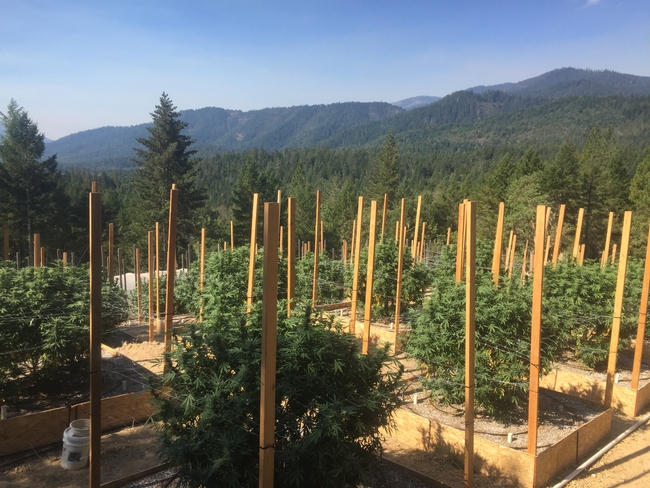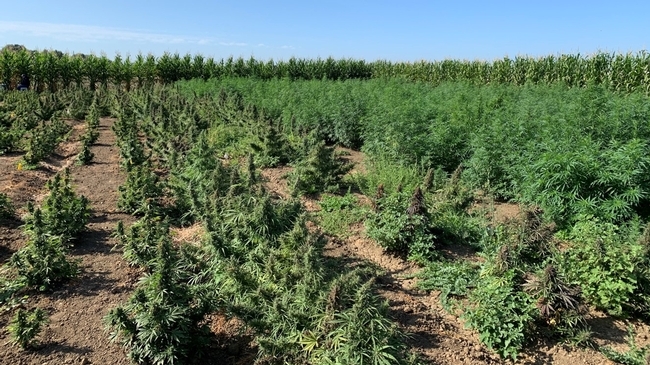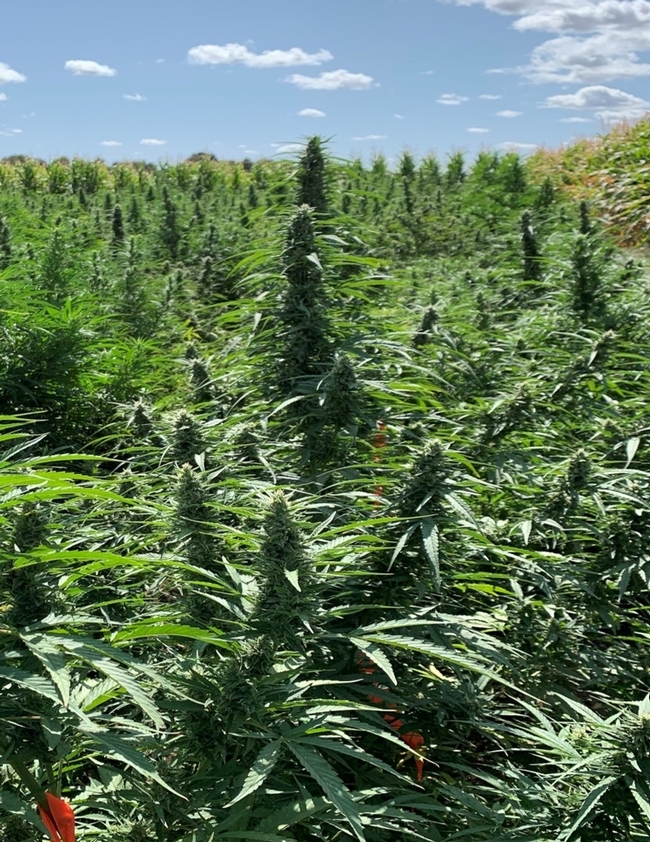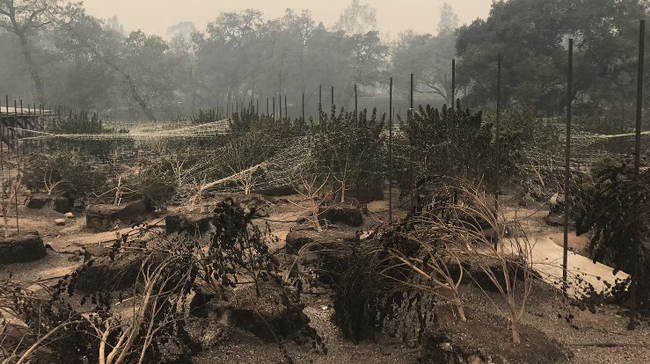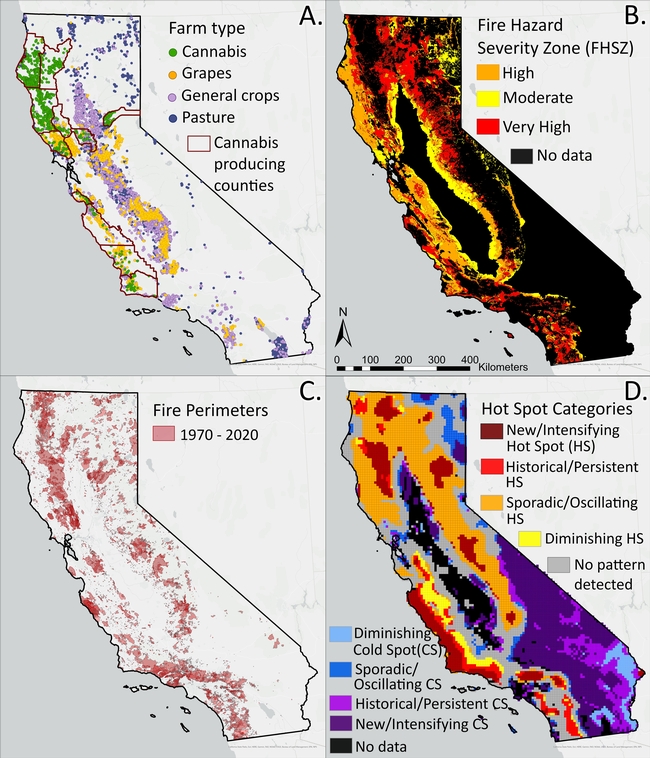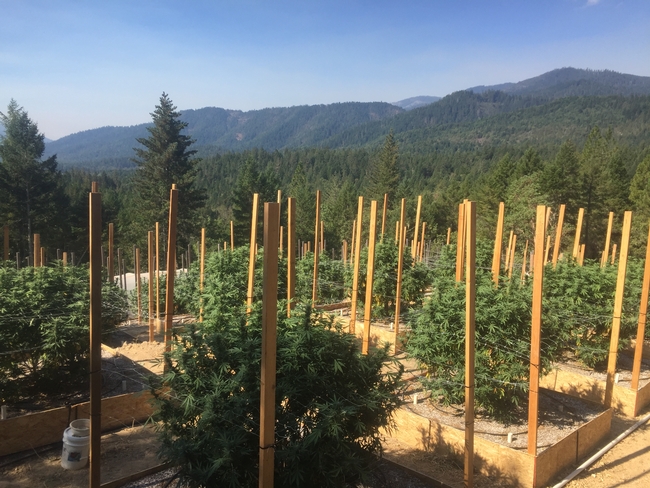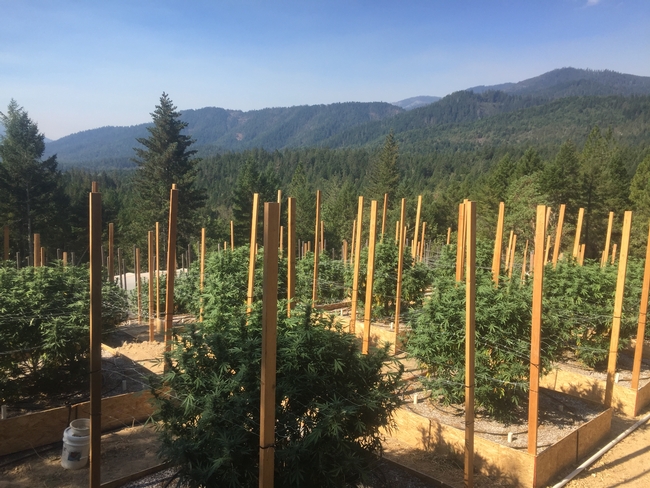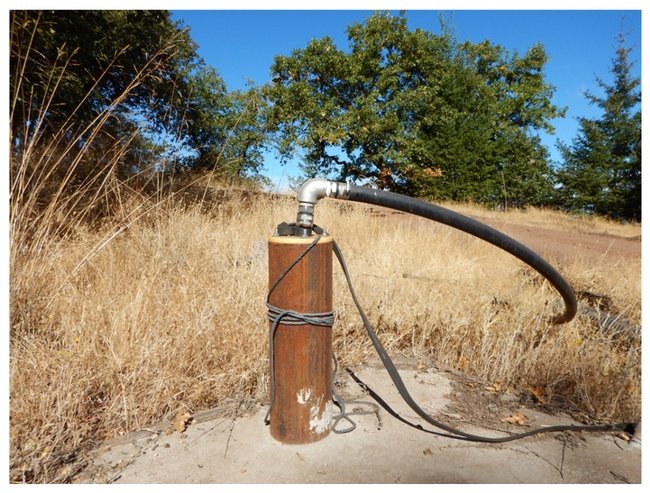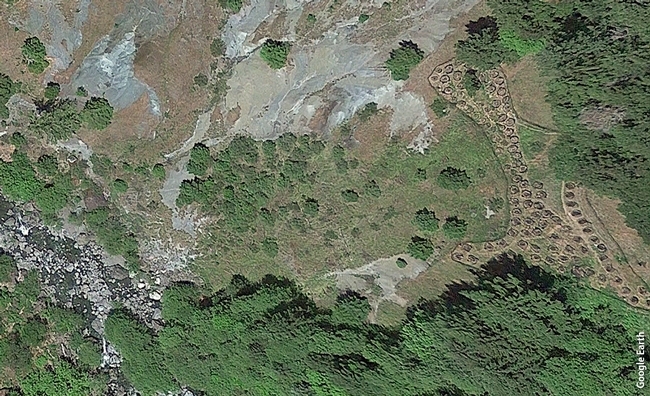Posts Tagged: Cannabis
Exploring the complexities of cannabis farming in rural areas
Land use change in agricultural frontiers can have far-reaching social and environmental implications, such as habitat loss, water contamination, or worker demographic shifts — particularly when it involves the rapid expansion of a new industry such as cannabis production. A recent study published in Landscape and Urban Planning offers an interdisciplinary perspective on the drivers of cannabis production in rural areas, using interviews with farmers and spatial modeling to uncover key factors.
Led by researchers from UC Berkeley's Department of Environmental Science, Policy, and Management (ESPM) and the Cannabis Research Center, the article “Where money grows on trees: a socio-ecological assessment of land use change in an agricultural frontier” provides a social-ecological systems approach for assessing drivers of cannabis production in Southern Oregon, using interviews with farmers and spatial modeling to uncover key factors.
"Unlike other crops, we have less understanding of where and how cannabis is grown, making it an important area of ongoing research," said Van Butsic, a professor of cooperative extension in ESPM and the senior author of the study.
The researchers interviewed 14 cannabis farmers to identify major themes around their relationships with land use, and used those themes to generate predictors for models of land use change. Most of the interview-derived drivers were significantly associated with cannabis distribution and development, including parcel size, human footprint, distance to the nearest cannabis farm, the density of local cannabis production, clearable land cover, farm zoning, elevation, roughness, and distance to rivers. The interview data also provided insights into the relationship of cannabis with social and environmental dynamics.
“We gained many insights from the interview data,” said lead author and ESPM postdoctoral scholar Phoebe Parker-Shames. “For example, we knew from previous research that cannabis development tends to be clustered, but we understand a little better now that this is related to the ways in which cannabis farmers rely on each other to share knowledge, labor, and navigate uncertainty during difficult policy changes.”
One of the major themes that emerged from the interview data was the environmental stewardship values of the farmers. “There is a large untapped potential for education and management outreach to target farmers who got into this industry in part because of their ability to connect with the land,” Parker-Shames said. “The farmers we spoke to had a genuine desire to learn best practices in an industry without a lot of formal standards for production. I'm grateful that they were willing to share their experiences and insights with us.”
Additional Berkeley co-authors include ESPM professor Justin Brashares and alumni Hekia Bodwitch (PhD '17 ESPM). The study's findings provide valuable insights into the drivers of cannabis production and the environmental stewardship values of cannabis farmers, which can inform environmental policy, regulation, and best practices for sustainable cannabis production.
UC to present hemp research at field day on Sept. 22
UC Cooperative Extension will host its first industrial hemp field day at UC Davis on Thursday, Sept. 22. The meeting will be held at the UC Davis Agronomy Field Headquarters on Hutchison Drive in Davis.
Industrial hemp is defined as Cannabis sativa L. and required not to exceed 0.3% THC, the intoxicating substance in marijuana.
University of California research on industrial hemp – which can be grown for oil, seed and fiber – began after the 2018 Farm Bill legalized the production of hemp as an agricultural commodity and removed it from the list of federally controlled substances.
At the field day, UC researchers will share research data and participants will explore field plots and learn about the agricultural practices commonly used for this crop.
“There is an abundance of potential end uses with hemp, and this is still very much a new crop with many research needs,” said Kadie Britt, a postdoctoral scholar in the Department of Entomology at UC Riverside and member of the management team for UC Agriculture and Natural Resources' Hemp Agroecology Network. “Growers are working to find their niche in this new and developing market.
Hemp is used as fiber for fabrics and textiles and its seed for oil and food. The cannabinoids, particularly cannabidiol, or CBD, have medicinal and recreational uses.
Registration for the free event will start at 7:30 a.m. From 8 a.m. to noon, attendees will hear from speakers representing the University of California, California Department of Food and Agriculture, California Department of Pesticide Regulation, Beneficial Insectary and Marrone Bio Innovations.
Topics will include hemp agronomy, weed pests, pathogen pests, insect pests, biocontrol use, pesticide use, pesticide resistance avoidance, and California hemp laws and regulations.
All interested people are encouraged to attend. Continuing education credits will be offered for California Department of Pesticide Regulation, Certified Crop Advisers, and Irrigation and Nitrogen Management Plan.
The agenda and more information about the field day are at https://ucanr.edu/sites/hemp/Events.
Registration is preferred, but not required: http://tinyurl.com/fielddayhemp.
Hemp Field Day Preview on KMJ 9-21-22
Wildfire poses greater threat to cannabis than other California crops
Wildfires are an increasing threat to people's lives, property and livelihoods, especially in rural California communities. Cannabis, one of California's newer and more lucrative commercial crops, may be at a higher risk of loss from wildfire because it is mostly confined to being grown in rural areas, according to new research by scientists in the Department of Environmental Science Policy and Management at UC Berkeley.
"Our findings affirm that cannabis agriculture is geographically more threatened by wildfire than any other agricultural crop in California,” said Christopher Dillis, lead author of the study and a postdoctoral researcher at UC Berkeley's Cannabis Research Center. “This is an issue in almost all major cannabis-producing counties, not only those in Northern California.”
With licensing to grow commercially in the state only since 2018, the $3 billion cannabis industry is already one of California's top five grossing agricultural commodities (though not included in the California Agricultural Production Statistics because USDA doesn't recognize cannabis as an agricultural crop). In 2020, California tax revenues from legal cannabis sales amounted to over $780 million.
To assess the risk of cannabis crops being burned by wildfire, the researchers analyzed licensed cannabis farms in 11 cannabis-producing counties. Dillis and his colleagues overlaid CAL FIRE maps of fire hazard severity zones, historic wildfire perimeters and areas likely to experience increased fire activity in the future with the locations of cannabis farms and other crops in Humboldt, Lake, Mendocino, Monterey, Nevada, San Luis Obispo, Santa Barbara, Santa Cruz, Sonoma, Trinity and Yolo counties. Legal cannabis cultivation is still prohibited in most other parts of the state.
CAL FIRE classifies fire hazard based on vegetation, topography, climate, crown fire potential, ember production and movement and fire history.
The researchers found cannabis fields were located in “high” and “very high” fire hazard zones and closer to wildfire perimeters more than any other crop. About 36% of the cannabis cultivation area, or 986 farms, were in high fire hazard zones and 24%, or 788 farms, were in very high fire hazard zones. Grapes had the next largest percentage of acreage in high (8.8%) or very high fire hazard zones (2.9%), followed by pasture at 4.3% and 1.7%, respectively.
“This work only serves as a starting point for understanding how vulnerable cannabis farms may be to wildfire, as this analysis did not include indirect impacts, such as smoke and ash damage, which may be far-reaching,” Dillis said. “However, we can confidently say that the places where cannabis continues to be grown are at greater risk now, and likely in the future as well."
For cannabis farms already established in high-risk areas, the authors recommend fire-safety programs to reduce the impacts of wildfire to crops and human health. They suggest traditional wildfire-risk reduction activities, such as managing vegetation and creating fire breaks, but also measures to prevent exposure of farmworkers and crops to wildfire smoke. In addition, they recommend the state pursue options for providing crop insurance to licensed cannabis farmers, which are available for most other agricultural crops through federal programs, but not cannabis.
“In light of the sector's growing economic importance in the state, the vulnerability of cannabis to wildfire should be considered in future cannabis and rural development policies,” said co-author Ted Grantham, UC Cooperative Extension specialist and director of UC Berkeley's Cannabis Research Center.
“The legal cannabis market in California is facing substantial headwinds from both market forces and a burdensome regulatory environment,” Grantham said. “This study shows that cannabis agriculture is uniquely exposed to wildfire impacts, which presents yet another challenge for licensed cultivators in the state.”
The Cannabis Research Center is currently conducting a statewide survey of licensed cannabis cultivators to better understand the impacts of wildfire on crops, infrastructure and farmworkers. The survey is funded through a grant from California's Department of Cannabis Control.
The study “The threat of wildfire is unique to cannabis among agricultural sectors in California” is published in Ecosphere and authored by Dillis, UC Cooperative Extension specialist Van Butsic, postdoctoral researchers Diana Moanga and Ariani Wattenberg, graduate student Phoebe Parker-Shames and Grantham.
Cannabis farms irrigating with groundwater may affect stream flows
The legalization of marijuana for recreational use in California has encouraged growers to expand plantings of the lucrative crop. Like any plant, cannabis requires water to grow. A new study from the Cannabis Research Center at UC Berkeley examined where cannabis growers in California are getting water for their crops, highlighting significant gaps in cannabis cultivation policy.
Environmental advocates have expressed concern that cannabis farms are diverting water from rivers and streams, which could harm fish and other wildlife.
The researchers studied water use in 11 of the state's top cannabis-producing counties – Humboldt, Lake, Mendocino, Monterey, Nevada, San Luis Obispo, Santa Barbara, Santa Cruz, Sonoma, Trinity, and Yolo.
Using California state cannabis permitting data, the researchers found that cannabis farms rely primarily on groundwater wells, not streams, for their irrigation needs. But pumping groundwater could also have an undesirable effect on wildlife.
“Wells drilled near streams in upland watersheds have the potential to cause rapid streamflow depletion similar to direct surface water diversions,” said co-author Ted Grantham, UC Cooperative Extension specialist and co-director of the Cannabis Research Center.
The Sustainable Groundwater Management Act, or SGMA, enacted in 2014, is designed to prevent overdraft of groundwater and protect water quality and supplies for agriculture, residents, fish and other wildlife.
But according to Grantham, “Most of the cannabis farms fall outside of the groundwater basins regulated under SGMA, so well use represents an important, but largely unregulated threat to streams in the region."
The researchers found that well use by cannabis farms is common statewide, exceeding 75% among farms that have permits to grow in nine of the 11 top cannabis-producing counties. In eight of the 11 counties, more than one-quarter of farms using wells are located outside of groundwater basins subject to state groundwater use regulations. Farms growing larger acreages of cannabis pumped more groundwater for irrigation, while farms with on-farm streams or located in areas that receive more rainfall were less reliant on wells.
The study relied on water-source data only for cannabis farms that have state permits to grow.
Based on models, the researchers estimate the majority (60%) of unregulated Northern California cannabis farms in Humboldt and Mendocino counties are likely to use groundwater wells if they follow the same patterns as the regulated industry.
“Our results suggest that proactive steps be taken to address groundwater use in cannabis regulations in California and call for further research into the effects of groundwater use on streamflow, especially outside of large groundwater basins,” write the authors.
The paper, “Cannabis farms in California rely on wells outside of regulated groundwater basins,” by Christopher Dillis, Van Butsic, Jennifer Carah, Samuel C. Zipper and Grantham is published in Environmental Research Communications at https://doi.org/10.1088/2515-7620/ac1124.
UC ANR scientists receive state cannabis research grants
Several scientists affiliated with the University of California Agriculture and Natural Resources have received grants from the California Bureau of Cannabis Control. The BCC awarded on Nov. 13 a total of $29,950,494 in public university research grants across California for research projects related to the implementation and effect of Proposition 64.
Research proposals had to fall within one of the several specified categories, including public health, criminal justice and public safety, economics, environmental impacts and the cannabis industry.
UC ANR-related cannabis projects and their principal investigators include:
Cannabis industry: Assessment of the location, structure, function, and demographics of licensed cannabis, focusing on geographical price differences, and differential impacts of local Prop 64-related regulations on the competitiveness of licensed businesses – Daniel Sumner, UC Davis professor in the Department of Agricultural and Resource Economics and director of the UC Agricultural Issues Center, $726,816
Economic impacts: Market prices for licensed and unlicensed cannabis and the effects of the current and alternate cannabis tax structures and tax rates on the private and public sectors in California, including government administrative costs and revenues - Sumner, $655,564
Environmental impacts of cannabis cultivation in California as affected by the farm economics of licensed and unlicensed cannabis production, including effects of testing regulations and compliance with the criminal prohibition of unlicensed cannabis - Sumner, $562,240
Assessing environmental impacts of cannabis-related noise and light disturbance to inform management of California wildlife – Justin Brashares, UC Berkeley professor in the Department of Environmental Science, Policy and Management, and Phoebe Parker Shames, graduate student, $489,762
Examining tribal sovereignty over cannabis permitting on native ancestral lands – Jennifer Sowerwine, UC Cooperative Extension specialist; Peter Nelson, professor; and Van Butsic, UC Cooperative Extension specialist; all in the UC Berkeley Department of Environmental Science, Policy and Management, $465,902
Cultivation bans, local control, and the effects and efficacy of Proposition 64 – Christy Getz, UC Cooperative Extension specialist in the UC Berkeley Department of Environmental Science, $328,916
Cannabis and wildfire: Current conditions, future threats, and solutions for farmers – Ted Grantham, UC Cooperative Extension specialist in the UC Berkeley Department of Environmental Science and Butsic, $319,091
Cannabis water-use impacts to streamflow and temperature in salmon-bearing streams – Mary Power, professor in the UC Berkeley Department of Integrative Biology, and Grantham, $314,417
The effect of local cannabis regulation on property prices – Butsic, $270,269
California cannabis workers: perceptions, beliefs, and knowledge of occupational health and industry hazards – Marc Schenker, professor in the UC Davis School of Medicine's Department of Public Health Sciences, $144,949
Related stories:
Cannabis Research Center at UC Berkeley https://rausser.berkeley.edu/news/2020/11/researchers-receive-grants-bureau-cannabis-control.
Cannabis and Hemp Research Center at UC Davis https://cannabis.ucdavis.edu/news/BCCawards
For a list of all public university projects funded by the Bureau of Cannabis Control, visit https://bcc.ca.gov/about_us/documents/media_20201113.pdf.


